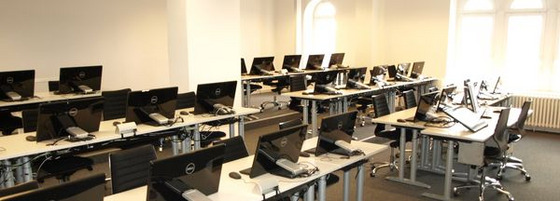Health Informatics Research Group
Health Informatics Research Group
The Health Informatics Research Group aims to contribute to the optimization of the quality, efficiency and cost-effectiveness of patient care and the management of health care facilities. It regularly publishes the IT Report Healthcare with current data from the IT landscape of health care facilities in Germany.
The Research Centre for Health and Social Informatics regularly publishes the IT-report healthcare. The report provides information on the current status of the use of information and communication technology in health care in Germany and Austria.
You can find the current report here.
The SHI Health Care Structure Act 2012 and the Health Care Strengthening Act 2015 have defined discharge management as part of hospital treatment. Hospitals are obliged to ensure care management to ensure a seamless transition from hospital treatment to inpatient or outpatient rehabilitation or care. Such seamless care management requires a continuous flow of information.
Similar to the doctor's letter, the nursing summary is used in transfer or discharge scenarios as a document for forwarding information (here: nursing information) across institutional boundaries. This applies regardless of the form of care or institution.
With the help of the nursing report, trained nursing staff aggregate their nursing documentation, which is based on the statutory nursing process. In this way, the nursing report forms the basis for communication with subordinate nursing facilities, but must not be seen as a forwarding of the nursing documentation. Previous nursing care reports are often form-based ("nursing care transfer forms"), whereby the structure or the contents queried can differ considerably between individual facilities.
The electronic nursing summary takes a new approach by providing a structure based on the nursing process, but leaving some of the transferred content open.
Based on a regional dataset, this was extended and the results coordinated at regional and national level in a consensus procedure.
The resulting sheet was evaluated and compared with a total of 114 transition sheets from German hospitals, nursing homes and outpatient nursing services to the question of whether the nursing content presented in the transition sheets can be represented in the ePflegebericht, which could be affirmed.
Within the framework of a feasibility study with real relocations, it was tested whether care transfer reports with the structure and contents of the ePflegebericht are technically and organisationally feasible and useful for the carers and those in need of care. The results showed that an electronic transition using the ePflegebericht can be integrated into everyday nursing practice, is technically feasible, and that the information transferred exceeded the quantity and relevance of the conventional transition forms.
Over time, the electronic nusing summary was presented at HL7 and implementation guidelines for HL7 CDA and HL7 FHIR were created. The CDA guidelines are currently in the process of being coordinated. The pre-final status can be viewed at http://wiki.hl7.de/index.php?title=IG:Pflegebericht. The FHIR guide is currently still under construction, but should also enter the voting process in the near future. It can be viewed at https://simplifier.net/guide/igepflegebericht/home.
Publications
Schulte G, Hübner U, Rienhoff O,Quade M, Rottmann T, Fenske M, Egbert N, Kuhlisch R, Sellemann B.Evaluation einer elektronisch unterstu?tzten pflegerischen U?berleitung zwischen Krankenhaus und Pflegeheim unter Nutzung einer Test-Telematikinfrastruktur: eine Fallanalyse. GMS Med Inform Biom Epidemiol 2017; 13(1):Doc02 (20170718)
Hübner U, Schulte G, Sellemann B, Quade M, Rottmann T, Fenske M, Egbert N, Kuhlisch R, Rienhoff O. Evaluating a Proof-of-Concept Approach of the German Health Telematics Infrastructure in the Context of Discharge Management. Stud Health Technol Inform. 2015;216:492-6.
Sellemann B, Schulte G, Egbert N, Hübner U, Rienhoff O. Erprobung des ePflegeberichts als Proof-of-Concept-System der elektronischen Patientenakte gem?? § 291a SGB V in der Region Osnabrück. In: Semler C, Schmücker P, Dujat C (Hrsg.): Tagungsband TELEMED 2014. 19. Nationales Forum für Gesundheitstelematik und Telemedizin. Berlin, 2014, S. 179-186.
Schulte G, Flemming D, Hübner U. Die Zukunft ist elektronisch. ePflegebericht. Die Schwester Der Pfleger; 5/2013: 494-498.
Schulte G, Hübner U, Flemming D. Versorgungskontinuit?t durch Information: Evaluation des HL7-Standards für den ePflegebericht. Tagungsband der 58. gmds Jahrestagung Lübeck 2013. http://www.egms.de/static/de/meetings/gmds2013/13gmds104.shtml
Flemming D, Schulte G, Hübner U. Evaluation des Deutschen HL7 CDA basierten elektronischen Pflegeberichts. Tagungsband eHealth 2013 Wien. Wien, ?sterreichische Computer Gesellschaft books@ocg.at., 2013, S. 86-92.
Hübner U, Flemming D. Standardizing the Electronic Nursing Summary: Motivation, Methods and Results. In: Weaver C, Delaney C, Weber P, Carr R (eds.) Nursing and Nursing Informatics for the 21st century: An International Look at Practice, Trends and the Future. 2nd edition. Chicago, HIMSS Press, 2010, S. 193-199.
Hübner U, Flemming D, Heitmann KU, Oemig F, Thun S, Dickerson A, Veenstra M. The Need for Standardised Documents in Continuity of Care: Results of Standardising the eNursing Summary. Stud Health Technol Inform. 2010;160: 1169-73.
Flemming D, Hübner U. Der elektronische Pflegebericht. Die Schwester der Pfleger. 2010;49 (5): 500-503.
Flemming D, Hübner U. Das Nursing Summary auf Basis der HL7 CDA. HL7-Mitteilungen Nr. 25. 2009:13-15.
Flemming D, Giehoff C, Hübner U (2008) Entwicklung eines Standards für den elektronischen Pflegebericht auf der Basis der HL7 CDA Release 2, Pflegewissenschaft - www.printernet.info 12/2008, 676-682.

The Center for Multimedia and IT Applications (ZeMIT) is a comprehensive institution of the Faculty of Business Management and Social Sciences. Its mission is to provide support and assistance for specific IT applications for companies and institutions in various industries, such as e-commerce and e-health or ERP (Enterprise Resource Planning) software. ZeMIT also serves as a competence center for e-learning applications at the Faculty WiSo and operates the Faculty's multimedia language laboratory as well as three IT training rooms with state-of-the-art equipment.
ZeMIT is an independent, cross-curricular laboratory, whose members are professors and employees of the faculty. It bundles the competence available in the faculty for highly innovative and complex applications. The laboratory cooperates with other laboratories of the faculties of the 新老虎机平台,最新老虎机 Osnabrück and uses their IT basic services. Further information can be found on the ZeMIT Homepage.